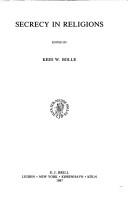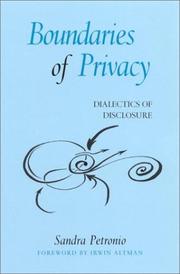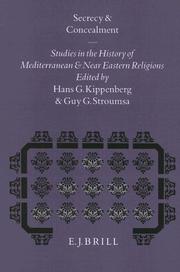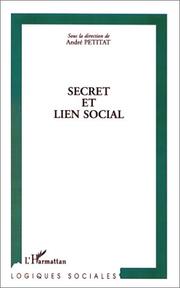| Listing 1 - 10 of 11 | << page >> |
Sort by
|

ISSN: 01698834 ISBN: 9004083421 9004378685 9789004083424 9789004378681 Year: 1987 Volume: 49 Publisher: Leiden,Boston Brill
Abstract | Keywords | Export | Availability | Bookmark
 Loading...
Loading...Choose an application
- Reference Manager
- EndNote
- RefWorks (Direct export to RefWorks)
Secrecy --- Secret --- Religious aspects --- Comparative studies --- Aspect religieux --- Etudes comparatives --- 291.211.8 --- -Concealment --- Privacy --- Hiding places --- Taboe --- -Comparative studies --- -Taboe --- 291.211.8 Taboe --- -291.211.8 Taboe --- Concealment --- Religious aspects&delete& --- Geheim / in de godsdienst. (Versch. onderwerpen) --- Godsdiensten. (Versch. onderwerpen) --- Mystère. (Mélanges) --- Secret / dans la religion. (Mélanges) --- Religions. (Mélanges) --- Mysterie. (Versch. onderwerpen) --- Religious education --- Religious education (Theology) --- Comparative studies. --- Philosophy.

ISBN: 0791487857 0585492468 9780585492469 9780791455159 0791455157 9780791487853 0791455165 9780791455166 Year: 2002 Publisher: Albany : State University of New York Press,
Abstract | Keywords | Export | Availability | Bookmark
 Loading...
Loading...Choose an application
- Reference Manager
- EndNote
- RefWorks (Direct export to RefWorks)
Offering a practical theory for why people make decisions about revealing and concealing private information, Boundaries of Privacy taps into everyday problems in our personal relationships, our health concerns, and our work to investigate the way we manage our private lives. Petronio argues that in addition to owning our own private information, we also take on the responsibility of guarding other people's private information when it is put into our trust. This can often lead to betrayal, errors in judgment, deception, gossip, and privacy dilemmas. Petronio's book serves as a guide to understanding why certain decisions about privacy succeed while others fail.
Interpersonal communication. --- Privacy. --- Secrecy. --- Self-disclosure. --- Communication --- Interpersonal relations --- Social psychology --- Secrecy --- Solitude --- Concealment --- Privacy --- Hiding places --- Disclosure of self --- Revelation of self --- Self-disclosing behavior --- Self-revelation --- Extraversion --- Interpersonal communication --- Self-disclosure

ISSN: 01698834 ISBN: 9004102353 9789004102354 9004378871 9789004378872 Year: 1995 Volume: 65 Publisher: Leiden ; New York : E.J. Brill,
Abstract | Keywords | Export | Availability | Bookmark
 Loading...
Loading...Choose an application
- Reference Manager
- EndNote
- RefWorks (Direct export to RefWorks)
This volume deals with secrecy and concealment in the history of mediterranean religions as pattern of social interaction. Secrecy is a powerful means in establishing identity and interaction as G. Simmel has demonstrated. Using his approach the scholars of this volume describe and explain the practical meaning of concealment in two different religious systems: in Egyptian and Greek polytheism and in Jewish, Christian, Gnostic and Shi'i monotheisms. This point of view reveals that all these religions shaped social norms concerning public and private aspects of the human self.
Secrecy --- Secret --- Religious aspects --- Congresses --- Aspect religieux --- Congrès --- Mediterranean Region --- Middle East --- Méditerranée, Région de la --- Moyen-Orient --- Religion --- Congresses. --- 291.1 --- -Concealment --- Privacy --- Hiding places --- Godsdienstfilosofie --- -Congresses --- Asia, South West --- Asia, Southwest --- Asia, Western --- East (Middle East) --- Eastern Mediterranean --- Fertile Crescent --- Levant --- Mediterranean Region, Eastern --- Mideast --- Near East --- Northern Tier (Middle East) --- South West Asia --- Southwest Asia --- Orient --- Circum-Mediterranean countries --- Mediterranean Area --- Mediterranean countries --- Mediterranean Sea Region --- -Congresses. --- -Godsdienstfilosofie --- 291.1 Godsdienstfilosofie --- -291.1 Godsdienstfilosofie --- Concealment --- Congrès --- Méditerranée, Région de la --- Religious aspects&delete& --- Asia, West --- West Asia --- Western Asia --- Secrecy - Religious aspects - Congresses.

ISBN: 2876731886 9782876731882 Year: 1994 Publisher: Seyssel: Champ Vallon,
Abstract | Keywords | Export | Availability | Bookmark
 Loading...
Loading...Choose an application
- Reference Manager
- EndNote
- RefWorks (Direct export to RefWorks)
Secrecy --- Imagination --- Secret --- Imaginaire --- Psychological aspects --- Aspect psychologique --- Freud, Sigmund, --- Pensée --- --Thème --- --Secret --- --Psychanalyse --- --Psychoanalysis --- Repression (Psychology) --- Psychoanalysis --- -Concealment --- Privacy --- Hiding places --- Defense mechanisms (Psychology) --- Psychology --- Psychology, Pathological --- Freud, Sigmund --- -Psychological aspects --- Thème --- Psychanalyse --- Secrecy - Psychological aspects --- Freud, Sigmund, - 1856-1939 --- Freud, Sigmund, 1856-1939 --- Psychoanalysis. --- Repression (Psychology). --- Psychological aspects.
Book
ISBN: 2908510278 9782908510270 Year: 2000 Publisher: Lille: Centre d'histoire judiciaire,
Abstract | Keywords | Export | Availability | Bookmark
 Loading...
Loading...Choose an application
- Reference Manager
- EndNote
- RefWorks (Direct export to RefWorks)
Privacy, Right of --- Secrecy --- Confidential communications --- Law and legislation --- Concealment --- Communications, Confidential --- Confidential relationships --- Confidentiality --- Privileged communications (Confidential communications) --- Professional secrets --- Secrets, Professional --- Privacy --- Hiding places --- Confession --- Criminal law --- Evidence (Law) --- Objections (Evidence) --- Personality (Law) --- Professional ethics --- Privacy, Right of - Congresses --- Secrecy - Law and legislation - Congresses --- Confidential communications - Congresses --- SECRET --- DROIT --- PHILOSOPHIE --- HISTOIRE

ISBN: 0804732000 9780804732000 Year: 1999 Publisher: Stanford: Stanford university press,
Abstract | Keywords | Export | Availability | Bookmark
 Loading...
Loading...Choose an application
- Reference Manager
- EndNote
- RefWorks (Direct export to RefWorks)
Defacement asks what happens when something precious is despoiled. It begins with the notion that such activity is attractive in its very repulsion, and that it creates something sacred even in the most secular of societies and circumstances. In specifying the human face as the ideal type for thinking through such violation, this book raises the issue of secrecy as the depth that seems to surface with the tearing of surface. This surfacing is made all the more subtle and ingenious, not to mention everyday, by the deliberately partial exposures involved in the public secret defined as what is generally known but, for one reason or another, cannot easily be articulated. Arguing that this sort of knowledge (knowing what not to know) is the most powerful form of social knowledge, Taussig works with ideas and motifs from Nietzsche, William Burroughs, Elias Canetti, Georges Bataille, and the ethnography of unmasking in so-called primitive societies in order to extend his earlier work on mimesis and transgression. Underlying his concern with defacement and the public secret is the search for a mode of truth telling that unmasks, but only to reenchant, thereby underlining Walter Benjamin s notion that truth is not a matter of exposure of the secret, but a revelation that does justice to it
Ethnology --- Secrecy --- #SBIB:39A9 --- Concealment --- Privacy --- Hiding places --- Philosophy --- Medische antropologie / gezondheid / handicaps --- #SBIB:39A5 --- #SBIB:39A3 --- #SBIB:1H30 --- Kunst, habitat, materiële cultuur en ontspanning --- Antropologie: geschiedenis, theorie, wetenschap (incl. grondleggers van de antropologie als wetenschap) --- Filosofie van de mens, wijsgerige antropologie
Book
ISBN: 9780812251616 081225161X 0812296842 Year: 2019 Publisher: Philadelphia, Pennsylvania : University of Pennsylvania Press,
Abstract | Keywords | Export | Availability | Bookmark
 Loading...
Loading...Choose an application
- Reference Manager
- EndNote
- RefWorks (Direct export to RefWorks)
What did it mean to keep a secret in early medieval England? It was a period during which the experience of secrecy was intensely bound to the belief that God knew all human secrets, yet the secrets of God remained unknowable to human beings. In Bonds of Secrecy, Benjamin A. Saltzman argues that this double-edged conception of secrecy and divinity profoundly affected the way believers acted and thought as subjects under the law, as the devout within monasteries, and as readers before books. One crucial way it did so was by forming an ethical relationship between the self and the world that was fundamentally different from its modern reflex. Whereas today the bearers of secrets might be judged for the consequences of their reticence or disclosure, Saltzman observes, in the early Middle Ages a person attempting to conceal a secret was judged for believing he or she could conceal it from God. In other words, to attempt to hide from God was to become ensnared in a serious sin, but to hide from the world while deliberately and humbly submitting to God's constant observation was often a hallmark of spiritual virtue.Looking to law codes and religious architecture, hagiographies and riddles, Bonds of Secrecy shows how legal and monastic institutions harnessed the pervasive and complex belief in God's omniscience to produce an intense culture of scrutiny and a radical ethics of secrecy founded on the individual's belief that nothing could be hidden from God. According to Saltzman, this ethics of secrecy not only informed early medieval notions of mental activity and ideas about the mind but also profoundly shaped the practices of literary interpretation in ways that can inform our own contemporary approaches to reading texts from the past.
Secrecy --- Concealment (Criminal law) --- God (Christianity) --- Monastic and religious life --- Spirituality --- Christian hagiography --- Riddles, English (Old) --- Latin poetry, Medieval and modern --- History --- Law and legislation --- Religious aspects --- Christianity --- Omniscience --- History of doctrines --- History and criticism. --- Cultural Studies. --- Literature. --- Medieval and Renaissance Studies. --- Religion. --- Religious Studies.
Book
ISBN: 0877054428 9780877054429 Year: 1980 Publisher: New York (N.Y.): Human sciences press,
Abstract | Keywords | Export | Availability | Bookmark
 Loading...
Loading...Choose an application
- Reference Manager
- EndNote
- RefWorks (Direct export to RefWorks)
Secrecy --- Privacy, Right of --- Official secrets --- Psychological aspects --- -Concealment --- Privacy --- Hiding places --- Invasion of privacy --- Right of privacy --- Civil rights --- Libel and slander --- Personality (Law) --- Press law --- Computer crimes --- Confidential communications --- Data protection --- Right to be forgotten --- Disclosing official secrets --- Government secrecy --- Secrecy in government --- Secrets, Official --- Secrets of state --- Criminal law --- Government and the press --- Government information --- Ministerial responsibility --- Law and legislation --- -Psychological aspects --- Secrecy - Psychological aspects
Book
ISSN: 09292470 ISBN: 9789004212077 9004212078 9786613345653 128334565X 9004215123 9789004215122 Year: 2012 Volume: 76 Publisher: Leiden ;Boston Brill
Abstract | Keywords | Export | Availability | Bookmark
 Loading...
Loading...Choose an application
- Reference Manager
- EndNote
- RefWorks (Direct export to RefWorks)
Mystery and secrecy were central concepts in the ritual, rhetoric, and sociological stratification of antique Mediterranean religions. That the ultimate nature and workings of the divine were secret, and either could not or should not be revealed except as a mystery for the initiated, was widely accepted among Pagans, Jews, and then Christians, both Gnostic and otherwise. The similarities and differences in the language of mystery and secrecy across religious and cultural borders are thus crucial for understanding this important period of the history of religions. The present anthology aims to present and analyze a wide selection of sources elucidating this theme, reflecting the correspondingly wide scholarly interests of Professor Einar Thomassen in honor of his 60th birthday.
Gnostic literature --- Gnosticism --- Manichaeism --- Mystery --- Secrecy --- History and criticism --- Nag Hammadi codices --- Gnosticism. --- Manichaeism . --- Mystery. --- Secrecy. --- 273.1 --- 273.1*35 --- Concealment --- Privacy --- Hiding places --- Mysteries (Revelation of God) --- Revelation --- Dualism (Religion) --- Philosophy, Ancient --- History and criticism. --- Gnosis. Gnosticisme --- Gnosis: Koptische bronnen: Nag Hammadi; Codex Jung; Evangelium veritatis --- Christianity --- Nag Hammadi codices. --- Nag Hammadi library --- Chenoboskion manuscripts --- Nag Hammadi manuscripts --- Khenoboskion manuscripts --- Najʻ Ḥammādī texts --- Nag Hammadi texts --- Festschrift - Libri Amicorum --- 273.1*35 Gnosis: Koptische bronnen: Nag Hammadi; Codex Jung; Evangelium veritatis --- 273.1 Gnosis. Gnosticisme --- Manichaeism. --- Cults --- Gnostic literature - History and criticism

ISBN: 273848820X 9782738488206 Year: 2000 Publisher: Paris: L'Harmattan,
Abstract | Keywords | Export | Availability | Bookmark
 Loading...
Loading...Choose an application
- Reference Manager
- EndNote
- RefWorks (Direct export to RefWorks)
Secrecy --- Social interaction --- Sociology --- Secret --- Interaction sociale --- Sociologie --- Social aspects --- Congresses --- Aspect social --- Congrès --- Association internationale des sociologues de langue française --- Interpersonal communication --- Official secrets --- Transparency in government --- Psychological aspects --- -Transparency in government --- Government in the sunshine --- Openness in government --- Sunshine, Government in the --- Transparence in government --- Public administration --- Concealment --- Privacy --- Hiding places --- Communication --- Interpersonal relations --- Disclosing official secrets --- Government secrecy --- Secrecy in government --- Secrets, Official --- Secrets of state --- Confidential communications --- Criminal law --- Government and the press --- Government information --- Ministerial responsibility --- Congrès --- Association internationale des sociologues de langue française --- Congresses. --- Secrecy - Psychological aspects
| Listing 1 - 10 of 11 | << page >> |
Sort by
|

 Search
Search Feedback
Feedback About UniCat
About UniCat  Help
Help News
News